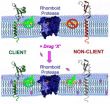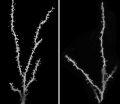Primary care physicians can be critical resource for abused women in rural areas
2014-08-21
(Press-News.org) Many primary care physicians in rural communities do not routinely screen women for intimate partner violence (IPV), according to Penn State medical and public health researchers. Rural women who are exposed to such violence have limited resources if they seek help.
"Rural health care providers are uniquely positioned to help women," said Jennifer S. McCall-Hosenfeld, a primary care physician and assistant professor of medicine and public health sciences, Penn State College of Medicine. "However, in rural settings, it might be even more important for physicians to step in, because there are few places for women experiencing IPV to turn. The physicians are in a good position to help, and may be the only option for rural women."
The researchers interviewed 19 primary care physicians who provide care to rural women in central Pennsylvania. The physicians answered questions that focused on IPV screening, perceptions of IPV as a health problem, current practices for responding to identified IPV and barriers unique to rural communities that affect care for women who have experienced IPV. McCall-Hosenfeld and her colleagues report their findings online and in the current issue of the Journal of Interpersonal Violence.
Only six of the physicians interviewed screened women for IPV, and within that group there was no standardized interval for screening. Seven participants did not think routinely screening every female patient for IPV was necessary.
"I don't think it's appropriate unless there's something to suggest it might be happening ... We have a lot of patients who come in and are happy, healthy, well-adjusted, and I'm not going to ask those if they're getting beaten on," explained one physician during the interview.
Nearly half of the physicians acknowledged that financial dependence on the abuser was a barrier for many women who might otherwise seek help for IPV. Eleven percent of the physicians also pointed out that patients may not even consider their family doctor as the person to go to for help.
"Patients often don't think of IPV as a health problem," said McCall-Hosenfeld, another barrier several physicians identified.
The United States Preventive Services Task Force now recommends IPV screening.
"IPV identification and treatment in primary care settings will also likely increase as a consequence of the Patient Protection and Affordable Care Act of 2010, as screening and counseling for domestic violence has been added as a primary preventive service that all private health plans must cover," the researchers wrote.
The researchers believe that women suffering violence in rural areas would be helped by providing training for PCPs, educating the community and improving access to referral services. McCall-Hosenfeld and colleagues note that future research should address both strategies to support PCPs' care of rural women as well as rural women's expectations and preferences for getting help within their communities.
INFORMATION:
Also working on this research were Carol S. Weisman, Distinguished Professor of Public Health Sciences and Obstetrics and Gynecology, and Cynthia H. Chuang, associate professor of medicine and public health sciences, both at the College of Medicine; and Marianne H. Hillemeier, professor of health policy and administration and demography, and Amanda N. Perry, graduate student in rural sociology.
The Penn State Clinical and Translational Sciences Institute and the Penn State Building Interdisciplinary Research Careers on Women's Health Program, supported by National Institutes of Health's Eunice Kennedy Shriver National Institute of Child Health and Human Development, supported this research.
ELSE PRESS RELEASES FROM THIS DATE:
Viruses take down massive algal blooms, with big implications for climate
2014-08-21
Algae might seem easy to ignore, but they are the ultimate source of all organic matter that marine animals depend upon. Humans are increasingly dependent on algae, too, to suck up climate-warming carbon dioxide from the atmosphere and sink it to the bottom of the ocean. Now, by using a combination of satellite imagery and laboratory experiments, researchers have evidence showing that viruses infecting those algae are driving the life-and-death dynamics of the algae's blooms, even when all else stays essentially the same, and this has important implications for our climate.
According ...
Biologists reprogram skin cells to mimic rare disease
2014-08-21
Johns Hopkins stem cell biologists have found a way to reprogram a patient's skin cells into cells that mimic and display many biological features of a rare genetic disorder called familial dysautonomia. The process requires growing the skin cells in a bath of proteins and chemical additives while turning on a gene to produce neural crest cells, which give rise to several adult cell types. The researchers say their work substantially expedites the creation of neural crest cells from any patient with a neural crest-related disorder, a tool that lets physicians and scientists ...
Sequence of rare kidney cancer reveals unique alterations involving telomerase
2014-08-21
HOUSTON – (Aug. 21, 2014) – An international scientific collaboration led by Baylor College of Medicine has revealed clues about genetic alterations that may contribute to a rare form of kidney cancer, providing new insights not only into this rare cancer but other types as well.
The collaboration, a project of the National Institutes of Health's Cancer Genome Atlas initiative, completed the sequence of chromophobe renal cell carcinoma and published the results today in the journal Cancer Cell.
"The Cancer Genome Atlas is a federally funded national effort that has ...
Some anti-inflammatory drugs affect more than their targets
2014-08-21
Researchers have discovered that three commonly used nonsteroidal anti-inflammatory drugs, or NSAIDs, alter the activity of enzymes within cell membranes. Their finding suggests that, if taken at higher-than-approved doses and/or for long periods of time, these prescription-level NSAIDs and other drugs that affect the membrane may produce wide-ranging and unwanted side effects.
More positively, the researchers say, their work provides the basis for a test that drug developers can use to predict and perhaps avoid these side effects in new medicines they make. A summary ...
Children with autism have extra synapses in brain
2014-08-21
NEW YORK, NY (August 21, 2014) — Children and adolescents with autism have a surplus of synapses in the brain, and this excess is due to a slowdown in a normal brain "pruning" process during development, according to a study by neuroscientists at Columbia University Medical Center (CUMC). Because synapses are the points where neurons connect and communicate with each other, the excessive synapses may have profound effects on how the brain functions. The study was published in the August 21 online issue of the journal Neuron.
A drug that restores normal synaptic pruning ...
Research explains how cellular guardians of the intestine develop
2014-08-21
Even the most careful chosen meal can contain surprises. To defend against infectious microbes, viruses or other potential hazards that find their way to the intestines, a dedicated contingent of immune cells keeps watch within the thin layer of tissue that divides the contents of the gut from the body itself.
New research at Rockefeller University sheds light on the development of a unique class of immune cells known as intraepithelial lymphocytes (IELs) that reside in this critical interface. The findings, published August 21 in Immunity, may help lead to new insights ...
Alternate mechanism of species formation picks up support, thanks to a South American ant
2014-08-21
A newly-discovered species of ant supports a controversial theory of species formation. The ant, only found in a single patch of eucalyptus trees on the São Paulo State University campus in Brazil, branched off from its original species while living in the same colony, something thought rare in current models of evolutionary development.
“Most new species come about in geographic isolation,” said Christian Rabeling, assistant professor of biology at the University of Rochester. “We now have evidence that speciation can take place within a single colony.”
The findings ...
Mouse model for epilepsy, Alzheimer's gives window into the working brain
2014-08-21
(SALT LAKE CITY)—University of Utah scientists have developed a genetically engineered line of mice that is expected to open the door to new research on epilepsy, Alzheimer's and other diseases.
The mice carry a protein marker, which changes in degree of fluorescence in response to different calcium levels. This will allow many cell types, including cells called astrocytes and microglia, to be studied in a new way.
"This is opening up the possibility to decipher how the brain works," said Petr Tvrdik, Ph.D., a research fellow in human genetics and a senior author ...
Hacking Gmail with 92 percent success
2014-08-21
RIVERSIDE, Calif. — A team of researchers, including an assistant professor at the University of California, Riverside Bourns College of Engineering, have identified a weakness believed to exist in Android, Windows and iOS mobile operating systems that could be used to obtain personal information from unsuspecting users. They demonstrated the hack in an Android phone.
The researchers tested the method and found it was successful between 82 percent and 92 percent of the time on six of the seven popular apps they tested. Among the apps they easily hacked were Gmail, CHASE ...
Researchers identify potential risk factors for urinary tract infections in young girls
2014-08-21
Winston-Salem, N.C. – August, 21, 2014 – Young girls with an intense, red, itchy rash on their outer genital organs may be at increased risk of developing urinary tract infections (UTIs), according to new research from Wake Forest Baptist Medical Center. The treatment may be as simple as better hygiene and avoiding potential irritants such as bubble baths and swimming pools.
"Vulvitis is a common condition affecting women and girls of all ages," said senior author Steve J. Hodges, M.D., associate professor of urology at Wake Forest Baptist. "We found that girls with ...





